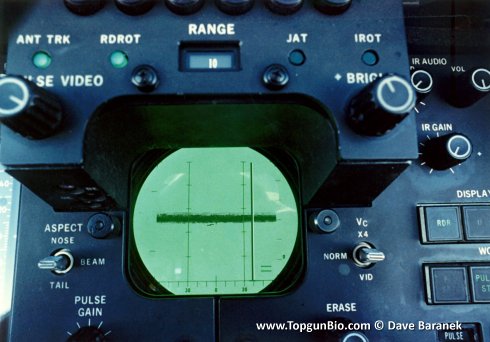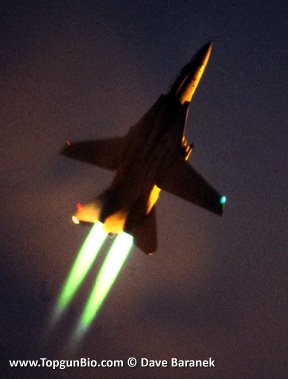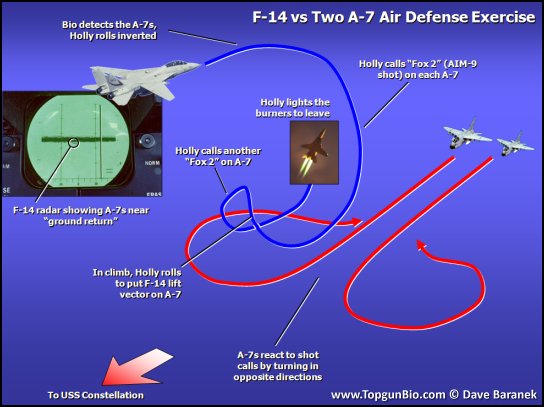Radar Scan Volume - A Lesson for a Young RIO
This is another story from my early days of flying the F-14.
One evening in June 1981 I was flying with Holly, operating from Constellation off the coast of Baja California several hundred miles southwest of San Diego. We had briefed at 5:15 PM for an air defense exercise, a common mission for F-14s during carrier ops. On this evening, two A-7 light bombers would launch first and immediately fly north at high speed, then turn inbound toward the carrier from 200 miles or more. Holly and I would be joined by another F-14 in our mission to defend Connie and take off a few minutes after the A-7s. We would delay overhead for 15 minutes, then patrol two slices of airspace and try to detect the A-7s. It seemed fairly simple and not particularly exciting, but you never know how a flight is going to go.
After launch we held overhead as required, then headed north, splitting the airspace into two sectors. Holly and I took the sector to the west. On this mission I had to search my entire sector by myself, but with the long range of the AWG-9 radar and its automated search modes, it should have been no problem to detect the inbound threat.
With each passing minute we flew four miles further from the carrier, while the A-7s approached at a slightly higher rate. Holly was calculating their probable distance from us based on their likely speed outbound, our delay time, and their probable speed inbound. After a few minutes he figured they were within our detection range, but I had nothing on the radar.
In front of my face a strobe swept back and forth on the small four-inch-square display that showed raw radar returns. This was called the detail data display (DDD). The strobe represented the radar’s 36-inch wide antenna mounted in the aircraft nose. At the end of each sweep hydraulics reversed the antenna’s direction of travel and adjusted its elevation. By the time it completed eight sweeps the radar had scanned a huge volume in both altitude as well as horizontal distance, and then repeated the scan pattern. But for this mission I spent most of my time looking down at the TID for a target symbol, not a blip of radar return. The TID was mostly black, marked only by lines showing the scan volume and various bits of information around its edges, not the targets we wanted.
It was possible that the A-7s were approaching in the other Tomcat’s sector, but once in awhile I sneaked a look in their area and didn’t see anything. Holly was a little impatient and asked if our radar was working. My own frustration was greater.
Finally I broke out of my “routine” mindset and thought about the problem. I had done a fair job of sanitizing the airspace, but realized I might have made a common mistake, allowing the targets to fly above or below the radar coverage. We had discussed this in classes and flight briefings, but I had been a little relaxed on this simple mission. So, bursting with frustration, I switched the radar to short-range mode, ten-mile scale, and pointed it almost straight down. I shifted my attention to the small screen showing the raw radar image. We were at 25,000 feet (roughly four nautical miles above the ocean), and there at four miles range was a solid black line, the ocean surface. But I immediately noticed two very distinct blips a fraction of a mile closer on the scope. They were the A-7s in formation at an altitude just a few hundred feet above the ocean. I couldn’t believe my luck.
“Got ’em. They’re right below us!” I said over the ICS. This was not a very professional call but it worked.
Holly immediately rolled our Tomcat inverted and pushed the stick slightly forward to keep us level for a few seconds. We both tilted our heads back to look toward the dark ocean and saw two gray jets cruising along four miles below us, headed toward the carrier. Holly pulled back on the stick gently and our nose fell through the horizon as we began a graceful arc.
As our speed increased in the dive, our wings automatically swept back from their low-speed position of 20 degrees to about 50 degrees, suitable for high subsonic speed. Their motion was silent and smooth.
About halfway through the dive, as Holly pointed our nose at the A-7s, I reached to my right and pushed a toggle switch back, activating an automatic scan-and-lock mode of the radar. In a second I saw two small green lights showing the radar was locked-on, and more importantly Holly had weapons-launch information on his head up display. (The weapon displays in the movie "Top Gun" are a reasonable depiction of what a Tomcat pilot saw.)
The A-7 pilots had kept up a good lookout. They had also calculated where they expected to be intercepted, based on speeds and distances, and they knew we would be above them since they were so low. In the purple evening light they had no trouble seeing us as we dove from above and a little behind them. They added power and climbed to complicate our attack, but it didn’t have a significant effect.
On most training missions there was a lot of talking over the radio as well as inter-cockpit communication. But since we were operating independently in our sector there was no radio communication. And since I had detected them so late, we had said little over the ICS. So it was unusually quiet as we accelerated in the dive. Halfway down, Holly casually called a simulated missile launch over the frequency assigned for the exercise, “Fox two on the lead A-7.”
He then paused and switched his aim to the wingman, and called, “... And there’s a fox two on the wingie.” Fox two was our term for shooting the Sidewinder heat-seeking missile.
We could have then zoomed past them and gone home, but that would be passing up a training opportunity. 
By the time we were near their altitude they had turned in opposite directions, a standard defensive tactic. We had a speed advantage from our dive so Holly climbed above them again and decide to attack the lead aircraft, telling me to watch the wingman. As we climbed and slowed, our wings automatically swept forward. While we were going straight up, Holly rolled our jet so that the lead A-7 was on our lift vector, an imaginary line perpendicular to our aircraft. He then pulled back on the stick to bring the nose to the target while I leaned forward in my seat and peered over the canopy rail to keep sight of the other jet. Since this was not a dedicated ACM engagement we did not use afterburner, so we did not fly as fast, turn as hard, or pull as many g’s. To me it seemed almost like slow motion.
We were inverted when Holly brought our nose to the lead A-7. “Fox two.”
I said, “Wingman has about 90 degrees to go" (until he is a threat). We rolled 90 degrees and made a hard right turn, starting a slight dive to keep our speed without using burner.
Now both A-7s were on our right side and below our altitude. It was just after sunset and bands of purple clouds lined the sky as I watched the two gray A-7s at my right four o’clock and low. They both started to pull their noses up in preparation for shooting us, but Holly decided we’d had enough training so he lit the burners.
The A-7s saw us nose-high at a relatively slow airspeed of about 250 knots, then saw two bright plumes emerge from our tail and become glowing cones of thrust, extending 50 feet behind us in the deepening twilight. This engagement was over as we steadily climbed away from the threat. “Okay, Bio, let’s go home.”
In two minutes my feelings went from frustration – no, of failure when I thought a threat had gotten past me – to satisfaction after we had shot both and were leaving them over the dark ocean. We checked in with Constellation’s controllers, went to holding, then made our night carrier landing.
A diagram of the action:

